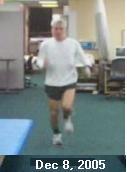
[If you click on image of Dec8, you can watch a video of the progression made between
nov22
nd and Dec8
th- Before clicking on link, keep in mind that on Nov 12,2005, I returned to Austin in a wheel chair only able to walk short distances without a cane. After watching the video, you'll need to use your browser's back<-
button to returned to this blog to read
how and why miracles happened on 32nd street.
For those of you who might not know, St. David's Hospital where I received tremendous care and therapy is on 32
nd Street in Austin. After days and weeks of work on drills to increase strength and coordinated control of my affected left leg, my therapist Jeanne and I began to focus on a progression of therapies to develop capacities specific to the running motion- applying (yet again) the axiom: instead of listening to the voice in me that says"I can't do that [e.g run]; asking "what are the steps I need to take before I can?". The snapshots above of November 22
nd and December 8
th depict a miraculous recovery no doubt- But the real miracle happened because I was fortunate enough to have access to a therapist[Jeanne] with an extraordinarily high level of training in
neuro development training and a real gift for working with and managing an over-zealous, impulsive, and injury-prone patient.
Jeanne was kind [smart] enough to video tape my first attempt at jogging. See link below to play video and listen to Jeanne's comments. Note: The video of my "performance " on Nov22 was in circulation on the Murphy family network and as you might expect source of great joy and celebration......Not so fast or so simple for Jeanne or me: My feet were barely off the ground; my left arm flailing limply and out of
synch with my right arm and leg! We were both excited and proud - but inspired to keep working towards the goal of running not shuffling.
This lead to a new round of carefully planned therapies and adjustments. Believe it or not the trick was mastering the skipping motion which took a few weeks and even that took some work on a drill that involved hopping
rapidly from left foot forward, right foot back position to right foot forward left back while holding onto the back of a chair or resting hands on a waist-high platform (think standing version of the hokey-
pokey). Improvement in arm motion was achieved with a simple, temporary adjustment: a little wrist weight and holding a baton in my affected left hand was enough to "engage" brain signal from brain to left arm to acquire sufficient control over my left arm.
Thanks to Jeanne's forethought to video a follow-up evaluation of my running motion on December 8
th, you can see the miraculous progression between Nov 22
nd and Dec 8
th. Click on see video link below[Note: this will take you to
youTube.com site after viewing video hit back button on your browser to return to brain under repair blog site]
Before clicking on link
remember: on November 12
th,2005 I returned to Austin in a wheel chair only able to walk short distances without a cane; and
remember how, why, and that miracles happen on 32nd street.
EPILOGUE:
Progressing from wheelchair to running so soon after my stroke was certainly miraculous. Reaching a point of physical recovery where I have been able to be able to jog through a 5K was hard work and a significant achievement; I'’m not yet at a point where running in or training for a competitive marathon would be possible. The same might be said of my cognitive recovery in terms of being ready to return to my career at the "competitive" level I was at prior to the stroke.
As those who see me on a daily basis know, I am enormously frustrated, disappointed and frightened over my residual physical and cognitive deficits. However, my recent experience participating as "honorary Stroke Survivor" in the Austin Heart walk presented a marvelous opportunity to apply my ability to run as far as I am currently able and to apply my available creative and verbal aptitude to execute a successful online fundraising campaign and to inspire hope and healing for others. These achievements provide provide me enormous appreciation for what I can accomplish and much needed energy and inspiration for pushing forward.
I am so grateful for the "“blessing" that my stroke happened outside areas that would have impaired my verbal abilities and that I am able to continue to work with a skillful speech/cognitive therapist to maximize what god-given cerebral capacities remain after a so significant an injury. Recall: a stroke is a Brain Attack. I am reminded of this many times every day. Please know that the process by which I compose and publish the entries on this blog are seldom easy, and that you are actively participating in my therapy and recovery when you visit my blog - So thanks for your time and attention to my recovery!




